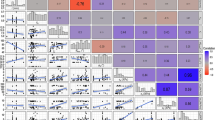Abstract
This article presents multivariate adaptive regression spline (MARS) for determination of elastic modulus (Ej) of jointed rock mass. MARS is a technique to estimate general functions of high-dimensional arguments given sparse data. It is a nonlinear and non-parametric regression methodology. The input variables of model are joint frequency (Jn), joint inclination parameter (n), joint roughness parameter (r), confining pressure (σ3) and elastic modulus (Ei) of intact rock. The developed MARS gives an equation for determination of Ej of jointed rock mass. The results from the developed MARS model have been compared with those of artificial neural networks (ANNs) using average absolute error. The developed MARS gives a robust model for determination of Ej of jointed rock mass.



Similar content being viewed by others
References
Arora VK (1987) Strength and deformation behavior of jointed rocks. Ph.D. thesis, Indian Institute of Technology, Delhi
Attoh-Okine NO, Mensah S, Nawaiseh M (2003) A new technique for using multivariate adaptive regression splines (MARS) in pavement roughness prediction. Proc ICE Trans 156(1):51–55
Attoh-Okine NO, Cooger K, Mensah S (2009) Multivariate adaptive regression (MARS) and hinged hyperplanes (HHP) for doweled pavement performance modeling. Constr Build Mater 23(9):3020–3023
Barton N (2002) Some new Q value correlate to assist in site characterisation and tunnel design. Int J Rock Mech Min Sci 39:185–216
Brown ET, Trollope DH (1970) Strength of models of jointed rock. J Soil Mech Found Div ASCE 96(SM2):685–704
Craven P, Wahba G (1979) Smoothing noisy data with spline functions: estimating the correct degree of smoothing by the method of generalized cross-validation. Numer Math 31:317–403
Friedman JH (1991) Multivariate adaptive regression splines. Ann Stat 19:1–141
Galera JM, Álvarez M, Bieniawski ZT (2006) Evaluation of the deformation modulus of rock masses using RMR. Comparison with dilatometer tests. In ISRM Eurock 2006
Hoek E, Diederichs MS (2006) Empirical estimation of rock mass modulus. Int J Rock Mech Min Sci 43:203–215
Lall U, Sangoyomi T, Abarbanel HDI (1996) Nonlinear dynamics of the Great Salt Lake: nonparametric short term forecasting. Water Resour Res 32:975–985
Leathwick JR, Rowe D, Richardson J, Elith J, Hastie T (2005) Using multivariate adaptive regression splines to predict the distributions of New Zealand’s freshwater diadromous fish. Freshw Biol 50:2034–2051
Lee TS, Chen IF (2005) A two-stage hybrid credit scoring model using artificial neural networks and multivariate adaptive regression splines. Expert Syst Appl 28:743–752
Maji VB, Sitharam TG (2008) Prediction of elastic modulus of jointed rock mass using artificial neural networks. Geotech Geol Eng 26:443–452
Moon HK, Na SM, Lee CW (1995) Artificial neural-network integrated with expert-system for preliminary design of tunnels and slopes. In: Fujii T (ed) Proceedings of 8th international congress on rock mechanics. Balkema, Rotterdam, pp 901–905
Roy N (1993) Engineering behavior of rock masses through study of jointed models. Ph.D. thesis, Indian Institute of Technology, Delhi
Shi JJ (2000) Reducing prediction error by transforming input data for neural networks. J Comput Civil Eng 14(2):109–116
Shi J, Ortigao JAR, Bai J (1998) Modular neural networks for predicting settlement during tunnelling. J Geotech Geoenviron Eng 124(5):389–395
Yaji RK (1984) Shear strength and deformation of jointed rocks. Ph.D. thesis. Indian Institute of Technology, New Delhi
Yang Y, Zhang Q (1997) A hierarchical analysis for rock engineering using artificial neural networks. Rock Mech Rock Eng 30(4):207–222
Yoo C, Kim JM (2007) Tunneling performance prediction using an integrated GIS and neural network. Comput Geotech 34:19–30
Zhang L, Einstein HH (2004) Using RQD to estimate the deformation modulus of rock masses. Int J Rock Mech Min Sci 41:337–341
Acknowledgments
Author thanks T. G. Sitharam and Vidya Bhushan Maji, for providing the data.
Author information
Authors and Affiliations
Corresponding author
Rights and permissions
About this article
Cite this article
Samui, P. Multivariate Adaptive Regression Spline (Mars) for Prediction of Elastic Modulus of Jointed Rock Mass. Geotech Geol Eng 31, 249–253 (2013). https://doi.org/10.1007/s10706-012-9584-4
Received:
Accepted:
Published:
Issue Date:
DOI: https://doi.org/10.1007/s10706-012-9584-4




